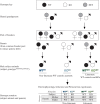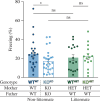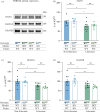Cage effects on synaptic plasticity and its modulation in a mouse model of fragile X syndrome
- PMID: 38853552
- PMCID: PMC11343313
- DOI: 10.1098/rstb.2023.0484
Cage effects on synaptic plasticity and its modulation in a mouse model of fragile X syndrome
Abstract
Fragile X syndrome (FXS) is characterized by impairments in executive function including different types of learning and memory. Long-term potentiation (LTP), thought to underlie the formation of memories, has been studied in the Fmr1 mouse model of FXS. However, there have been many discrepancies in the literature with inconsistent use of littermate and non-littermate Fmr1 knockout (KO) and wild-type (WT) control mice. Here, the influence of the breeding strategy (cage effect) on short-term potentiation (STP), LTP, contextual fear conditioning (CFC), expression of N-methyl-d-aspartate receptor (NMDAR) subunits and the modulation of NMDARs, were examined. The largest deficits in STP, LTP and CFC were found in KO mice compared with non-littermate WT. However, the expression of NMDAR subunits was unchanged in this comparison. Rather, NMDAR subunit (GluN1, 2A, 2B) expression was sensitive to the cage effect, with decreased expression in both WT and KO littermates compared with non-littermates. Interestingly, an NMDAR-positive allosteric modulator, UBP714, was only effective in potentiating the induction of LTP in non-littermate KO mice and not the littermate KO mice. These results suggest that commonly studied phenotypes in Fmr1 KOs are sensitive to the cage effect and therefore the breeding strategy may contribute to discrepancies in the literature.This article is part of a discussion meeting issue 'Long-term potentiation: 50 years on'.
Keywords: CFC; Fmr1; LTP; NMDAR PAM; STP; littermate syndrome.
Conflict of interest statement
G.L.C. and D.E.J. are on the Scientific Advisory Board of Hello Bio, a supplier of UBP714.
Figures





Similar articles
-
Altered structural and functional synaptic plasticity with motor skill learning in a mouse model of fragile X syndrome.J Neurosci. 2013 Dec 11;33(50):19715-23. doi: 10.1523/JNEUROSCI.2514-13.2013. J Neurosci. 2013. PMID: 24336735 Free PMC article.
-
Impaired bidirectional NMDA receptor dependent synaptic plasticity in the dentate gyrus of adult female Fmr1 heterozygous knockout mice.Neurobiol Dis. 2016 Dec;96:261-270. doi: 10.1016/j.nbd.2016.09.012. Epub 2016 Sep 19. Neurobiol Dis. 2016. PMID: 27659109
-
Rescue of NMDAR-dependent synaptic plasticity in Fmr1 knock-out mice.Cereb Cortex. 2015 Jan;25(1):271-9. doi: 10.1093/cercor/bht237. Epub 2013 Aug 22. Cereb Cortex. 2015. PMID: 23968838
-
BDNF in fragile X syndrome.Neuropharmacology. 2014 Jan;76 Pt C:729-36. doi: 10.1016/j.neuropharm.2013.05.018. Epub 2013 May 29. Neuropharmacology. 2014. PMID: 23727436 Review.
-
Long-term potentiation and the role of N-methyl-D-aspartate receptors.Brain Res. 2015 Sep 24;1621:5-16. doi: 10.1016/j.brainres.2015.01.016. Epub 2015 Jan 22. Brain Res. 2015. PMID: 25619552 Free PMC article. Review.
Cited by
-
Long-term potentiation: 50 years on: past, present and future.Philos Trans R Soc Lond B Biol Sci. 2024 Jul 29;379(1906):20230218. doi: 10.1098/rstb.2023.0218. Epub 2024 Jun 10. Philos Trans R Soc Lond B Biol Sci. 2024. PMID: 38853569 Free PMC article.
-
A key role for P2RX5 in brown adipocyte differentiation and energy homeostasis.Adipocyte. 2024 Dec;13(1):2421745. doi: 10.1080/21623945.2024.2421745. Epub 2024 Nov 1. Adipocyte. 2024. PMID: 39484996 Free PMC article.
References
MeSH terms
Substances
Grants and funding
LinkOut - more resources
Full Text Sources
Medical
Research Materials
Miscellaneous

